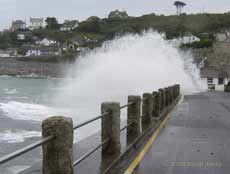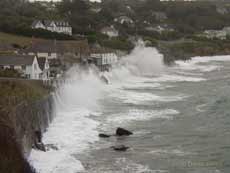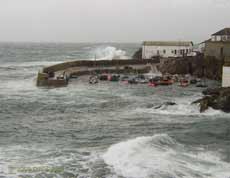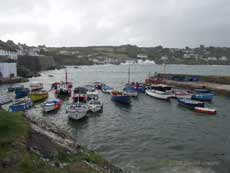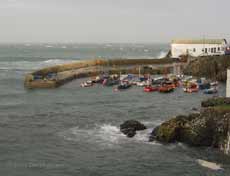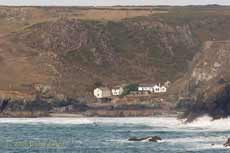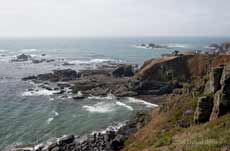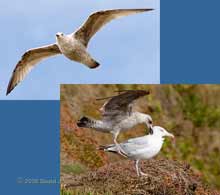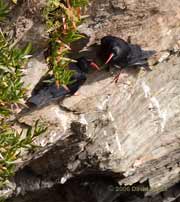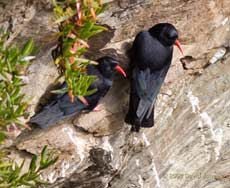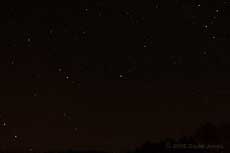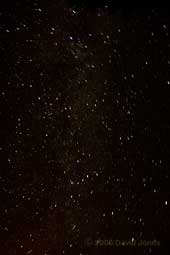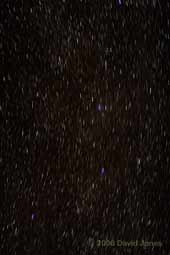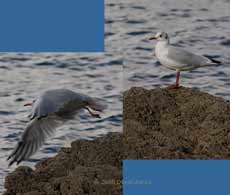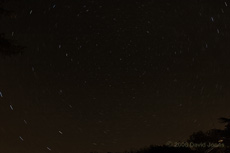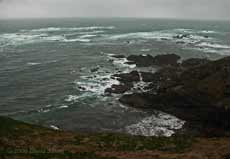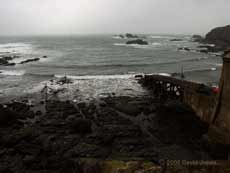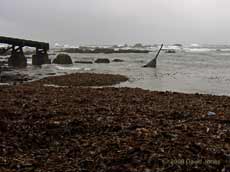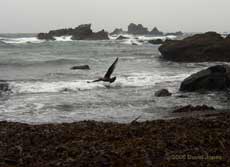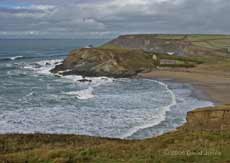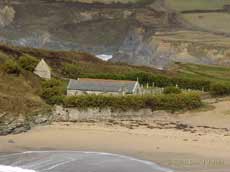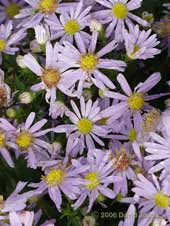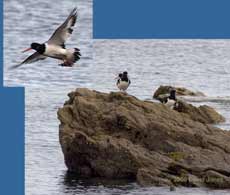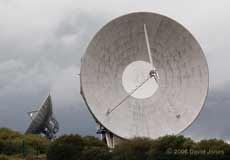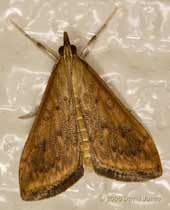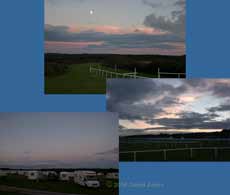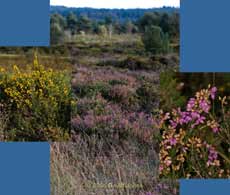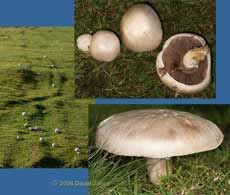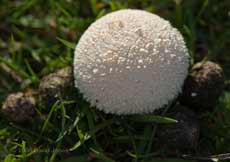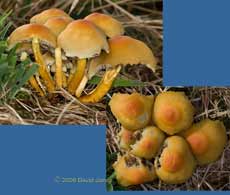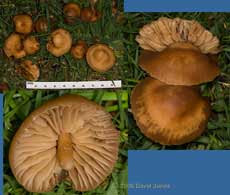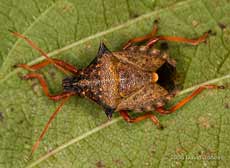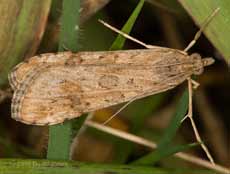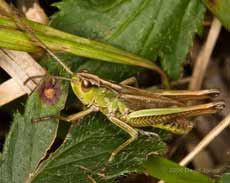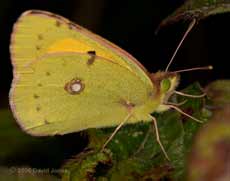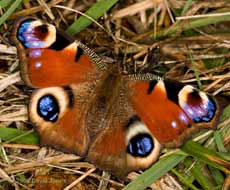Go to the last entry on this page .....Go to previous entry21 September - The mild, dry weather continued, but the wind picked up through the day as Gordon got nearer. It was very gusty, and by the end of the afternoon these were being reported as being over 50mph. Just in case it got worst, we added some more guy-ropes to our caravan awning. However, the weather forecast on TV tonight reported that the worst of the winds have now passed us, and that Wales should watch out for winds of up to 80mph, so it looks as though we have escaped the worst of the storm.
This shot shows how that road becomes a salty 'car wash' if you get your timing wrong!
Safely past that spot, I parked to look back at this same area from a higher vantage point.
Coverack was originally a fishing village, and the small headland at the western end of the bay helps to shelter a small harbour, which is still usually full of fishing boats. This afternoon the waves were just able to break over the harbour wall.
Today's pictures were taken at around high tide, fortunately not a Spring tide. At the beginning of the month there was the highest Spring Tide for a long time. That was over a metre higher than today's tide, and there will be another, almost as high tide at the beginning of October. The effect of a storm combined with such tides cause major problems for coastal communities.
This shot shows more clearly the shelter provided by the harbour. It looks deceptively calm until you notice the breaking waves in the background.
Finally, while the skies were grey for most of the time, just as we were about to leave, a break in the clouds allowed sunshine to get through to light up the harbour and give it a much 'warmer' look. The white building behind the harbour wall was once a lifeboat station. These days the area is served by the Falmouth and Lizard lifeboats, and the building is a restaurant.
Tonight, at 9.45pm the sound of the wind in the trees around us has died down a lot, so it looks as though the forecaster was correct earlier on!
22 September - A 'no camera' day. We went off the Lizard peninsular to get some LPG for our Discovery and to a bit of shopping for supplies. The weather was good again, if still breezy.
23 September - It rained during the night, but a south-easterly breeze ensured that the field was dry under foot by the time we got up this morning, even before the early sunshine got to work! Back to Lizard Point today, with the weather as good as many a summer's day. The temperature in the shade reached just over 21C, but it felt much warmer in the sunshine. It wasn't long before I spotted the Choughs landing in the field where I photographed them a few days ago. On this occasion though, by the time I got there with my camera they had decided to move on. They landed again by Old Lizard Head, where the land takes a sharp right-hand turn to head north along the Lizard's west coast. It took me a while to get there and, needless to say, I just missed them again.
This is the view you get of Kynance from Old Lizard head.
I headed back to Lizard Point, and as I did so the Choughs flew low over me, carrying on past Sheila.
The point is a 'way point' for shipping and there are usually at least a couple of ships in sight. Today it was quite hazy, but you may just make one out beyond the rocks. I always think that the best time to visit the Point is when the tide is low, exposing more of the rocks that extend out to sea.
Here, a juvenile Herring Gull lands next to a parent to beg for food. The adult is perched on a hump that is completely covered by Purple Dewplants, the smaller leafed of the two invasive species. The Gulls' young were being fed on the nest when we were here in the Spring, and while they are now perfectly good fliers, they are still somewhat dependent after all this time.
I still only managed to get a clear shot of a leg of one of the pair, the absence of any rings indicating that it is an (they are?) adult bird(s). To their left you can see the other invasive species, the Hottentot Fig that is spreading to cover this favourite perch (judging by the bird droppings on the rocks).
I tucked myself down out of sight and took several pictures of them before one all but disappeared behind the fig's foliage.
Then I just watched until some minutes later they decided to take to the wing again, spiralling up out of the area around the cave entrance and passing just feet from me as they headed west to the fields again - it's fascinating to see the close bond between the pair. I wonder how the young Choughs are doing. I haven't seen any of the offspring here outside of the fledging periods.
25 September - The last two days have been much more autumnal. The night before last, we could see the distant flashes of a distant thunderstorm, but other all we had was a bit of rain. Yesterday was mainly dull but dry, and we stayed on the campsite all day, save a quick trip out for supplies. Last night, with the sky clear again, after 9pm I pointed my camera skywards. The results are not great (I need more practice) but here are a few to show how clear it was.
You can see the constellation Cassiopeia in the top right corner.
In this second image I used the camera in portrait format to follow the main band of the Milky Way. The stars appear as short dashes as the shutter was open for three minutes. I'm not happy with the focusing in all three pictures, but this one does show quite clearly some of the fantastic number of stars that you should be able to see on a clear night.
Finally, a three second exposure taken of part of that same area of sky through a 'longer' lens. It's a bit like abstract art but it does show something of the density of stars in the Milky Way. When we return home I will take similar shots from my garden to compare with these.
Today we headed down to Porthallow again. It was fine, and there was lots of sunshine all around us but for much of the time the cove stayed under a grey cloud! The sea was flat calm and I went out on my kayak for just the second time this holiday.
We were amused by the antics by a pair of what I think are non-breeding Black-headed gulls that were very put out when an juvenile Herring gull tried to muscle in on some scraps of bait left by a fisherman. They tried to chase it away but seemed to be put off by its larger size.
26 September - Another day spent down Porthallow, and another kayak trip. A breeze meant the sea was not as calm as yesterday, but the paddling was still very enjoyable. A forecast of strong winds over the next few days suggests that this will be the last time on the sea during this holiday. As well as numerous Cormorants (or are they Shags??) I saw several groups of Oystercatchers (including juveniles) and three Small Egrets. It's been disappointing not to see any Basking Sharks this year, and I'm told that last week I missed a Common Seal that came to the shore near the cove.
You can see the rectangle of the Plough in the bottom left corner, and four of the five major stars of Cassiopeia in the top right.
I said nearly ten minutes because I retired to the caravan during the exposure and on my return just before the ten minutes were up I managed to kick the tripod leg. I had to stop the exposure prematurely, but not before the movement was recorded in the shot! I didn't get a second chance because clouds moved in to hide much of the view.
27 September - After yesterday's decent weather, today was decidedly different, with grey skies and windy conditions from the start as gales arrived from the south. It wasn't so windy in the morning when we spent a short time at Coverack at low tide. In the past I have paddled with dolphins there, but today we saw a Common Seal there for the first time. It was very close to the shore, but by the time I put a suitable lens on my camera it had moved too far away for a photograph. We headed to Lizard Point in the afternoon. By then it was windier and the skies were darker. After a 'cream tea' (we usually ration ourselves to one each holiday!) at the Polpeor Cafe, which was almost cut short by rain I took some more pictures of the Point. That is the first time this year that our time at the cafe has been threatened by rain. There is an indoor area, but we far prefer to enjoy the view as we enjoy their offerings, and their friendly service.
One choice is a new station in Polpeor Cove below the Lizard Point, where it used to be up to 1961. The picture shows how the slipway of that old station points out through a gap in the treacherous rocks that give only limited protection from south-westerly gales.
This second picture, taken from the small beach in the cove, shows the rocks to the left of the slipway,
and then the rocks to the right of it - not a welcome sight if the boat chooses to return to station during a storm, especially at night. The sea today was not particularly rough. The beach of the cove is mainly made up of a coarse sand, but little of that was visible today as the gathering storm had washed in large quantities of seaweed, mainly Laminaria, on the early morning high tide. As well as the gulls, Rock Pippits flitted between ledges in the rocks and there were still a few Swallows about. I got back to the Discovery just in time as the skies opened and it poured with rain - and we heard the Lizard foghorn for the first time this trip. 28 September - The autumnal weather continued today. It was fine, with bright periods this morning when we popped to Mullion this morning. I took a few minutes to return to the headland between Poldhue and Church Cove to take a couple more pictures.
First, a closer view of Church Cove, the beach deserted in the blustery conditions,
and then a closer look at Gunwalloe Church that gives the cove its name. Unusually, its tower is detached from the rest of the church. Behind it you can just make out the sea in the beach of Jangye-ryn.
Up on the headland where I parked, the greens and browns of the vegetation are brightened up by clumps of vivid Asters, which I first thought were Sea Asters, but am now not so certain.
We ended up at Porthallow in the afternoon. After sitting outside for a while we had to retreat back into the Discovery when low cloud rolled in from over the land and there was heavy rain. Before that happened I had the opportunity to take a couple of pictures of this trio of Oystercatchers. Usually I don't get close enough to get a photograph, and on this occasion the movement of another person on the rocks was enough to send them noisily across the bay. I'm sure that we have seen Oystercatchers more often here this year than in the past.
The nearest dish has been here since it was built to carry the first transatlantic satellite signals via Telstar in 1962. There are over sixty other dishes here.
Last week, the local newspaper revealed that all its satellite communications will probably be transferred to elsewhere in the UK over the next two years, and that all the dishes, with the exception of the 'Telstar' dish, which is a 'listed building', will probably be removed.
29 September - We awoke to heavy rain this morning but then things cleared up for the afternoon. During a period of brightness there were several Speckled Wood butterflies fluttering about, but no sign of any Clouded Yellows. As evening approached another heavy storm arrived, complete with hail and with a lightning strike nearby that knocked out the power supply for a few seconds.
Just one photograph today, of a pyralid moth, a Rusty-dot Pearl (Udea ferrugalis) - thanks to Tim Norriss for the ID. It's the first moth to find its way into our caravan awning this holiday, and one of no more than a handful of moths that we have seen over these last two weeks. It measured just over 13mm in length and was nearly 12mm wide.
Following my comments about being able to see the Milky Way here, it was interesting to hear on the news today that Reykjavik in Iceland organised a turning off of the town's lighting last night so that people could see the stars - what a great idea, although It seems it was cloudy!
30 September - A bright and sunny start after a somewhat sleepless night. Sometime between 4 and 5am I took a trip up to the men's washrooms and had an encounter with a bat there! In the past I have often see evidence of their visits there, in the form of moth wings scattered on the floor. There are bat roosts amongst the rafters of some of the buildings here, and sometimes the owner finds them hanging from the ceiling of a garage that he uses. Back outside, the sky was absolutely clear and the display of stars nothing short of brilliant. During the day the weather fluctuated between bright periods and heavy rain showers as we started the process of packing up for the trip home. We managed to get the caravan awning folded dry just before a long dry spell came to an end with another downpour. Unfortunately, Sheila slipped and hurt her arm and leg so she found the rest of the day rather painful.
2 October - We should have been home today, but instead I'm writing this in the middle of Exeter Racecourse. Bad weather meant that yesterday was a miserable day to travel, and I was very glad when we reached Exeter, and this morning it was an easy decision to postpone the second part of our journey so that we could both have a rest.
Today the weather has been much calmer, with only one heavy shower all day (which occurred while we were our getting provisions!), and these pictures show the sky around the racecourse as dusk fell this evening. Tonight the forecast is for lower temperatures than we have had so far this holiday.
The course is set at the top of a hill and is surrounded by woods on three sides. The area in the middle is covered largely by areas of gorse, heather and bracken, with clear areas that are heavily grazed by the very high rabbit population. There are Adders here, and also deer in the woods that come in and do a lot of damage to the racetrack.
There are lots of birds here, including warblers of various sorts but other than the Pied Wagtails that dash about between the caravans and campers, I didn't try to spot any of them. Instead, this afternoon I went for a gentle stroll to look for smaller things.
I don't have a fungus guide with me so identification of these and the ones that follow wasn't possible.
At the side of the clearing saw this small one with a spiky surface that appeared different to the others. It was surrounded by rabbit droppings, each around 1cm in diameter.
In a rougher area of vegetation I saw just one example of the fungus.
Back near the caravan, a power supply point was surrounded by these fungi. While superficially similar to the previous ones, these didn't occur in tight clumps, and were certainly darker.
The walk also turned up some insects. First was this Shield Bug which is new to me. A look in my insect guide suggests that it is Picromerus bidens, a species found in dense vegetation and as an adult hunts for caterpillars and other young insects. The sharp spines on its pronotum (the hard cover of its thorax) are an identifying feature.
Next, there seemed to be numerous of these moths, identified by Tim Norriss as the pyralid moth Rush Veneer (Nomophila noctuella), a very common migrant species. They kept low over the undergrowth.
and small numbers of grasshoppers, including this little one that was very patient as I edged my camera closer. Tim confirms it as a Meadow Grasshopper (Chorthippus parallelus), a very common species.
As set off for my walk, the first of only a few butterflies seen was another Clouded Yellow. I couldn't get close to that one, but I saw this second one near the end of my trek. That was great to see, but
It has to be one of the most vividly coloured examples I have seen for a very long time. The photograph just couldn't capture quite how iridescent the blue was. It's wings were perfect, and it looked as though it had only emerged very recently.
Tonight, the camera is packed away, and we are getting ready for another attempt at the homeward journey in the morning, with the prospect of one of our sons being at home to help put the caravan away when we arrive so that Sheila can rest her arm which is still quite painful. Click on the images to see larger versions - |
|
